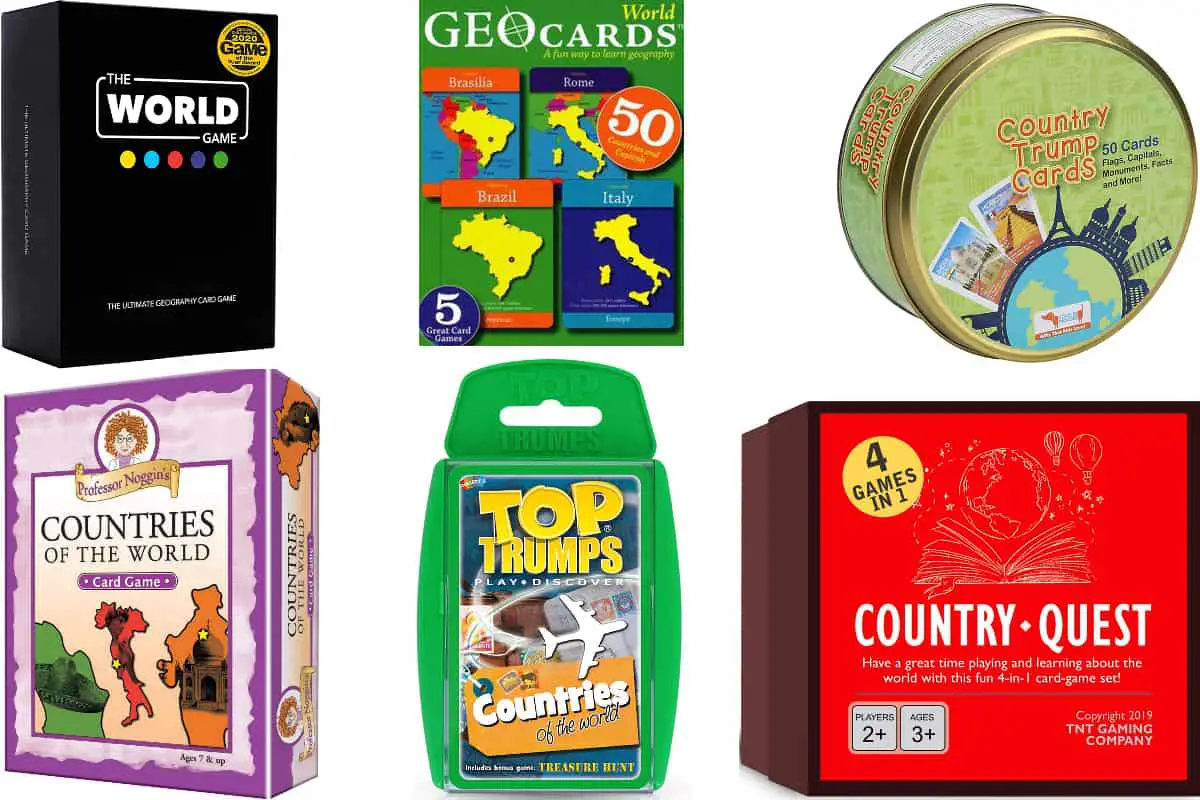This post contains affiliate links.
Dedicated card games are a great way to memorize world countries. Cards can be summaries of important country attributes. And a good game mechanism makes going through a tedious list of countries an engaging experience.
The six countries of the world card games I found belong to three categories:
- Multi-attribute games, with Country Quest
 having the coolest information about countries as well as more gameplay variation
having the coolest information about countries as well as more gameplay variation - Quiz games, with Professor Noggin’s Countries of the World being the most comprehensive, challenging, and exciting one for families
- Flashcards, such as Geocards World

Countries of the World Card Games Comparison Table
| Game | Type | Age | Players | For | Price | Rating |
| GeoCards World | Flash Card | 4+ | 1‑4 | Teachers, Families | $$$ | ★★★☆☆ |
| Country Trump Cards | Multiple Categories | 5-12 | 2‑5 | Families | $$ | ★★★☆☆ |
| Country Quest | Multiple categories | 6+ | 2‑5 | Teachers, Families | $$ | ★★★★☆ |
| Top Trumps | Multiple categories | 7-15 | 2‑6 | Families | $ | ★★★★★ |
| The World Game | Multiple categories, Quiz | 7-15 | 2‑5 | Teachers,Families | $$$ | ★★★★☆ |
| Professor Noggin’s | Quiz | 7+ | 2‑8 | Families | $$ | ★★★★★ |
Countries of the World Card Games For Preschoolers
In this section, I list three card games that preschoolers can play at home and school. The card’s content is easy to understand by 4-5 year old children, but you can modify game mechanics to suit adults.
Generally, the following card games are played by 2 to 6 players competitively, but children may cooperatively play these games because:
- the main goal is to provide basic information about the Country one at a time
- there are definite answers, so comparing information on the cards is easy and fast
- the cards are either too big and heavy for children’s hands or too soft and light for children to hold
- they can enjoy as many rounds as they can because the card contains multiple characteristics
You can also play these games alone in self-review mode and memorize the countries’ names by looking at the card’s flags or pictures.
Country Trump Cards (CocoMoco Kids)
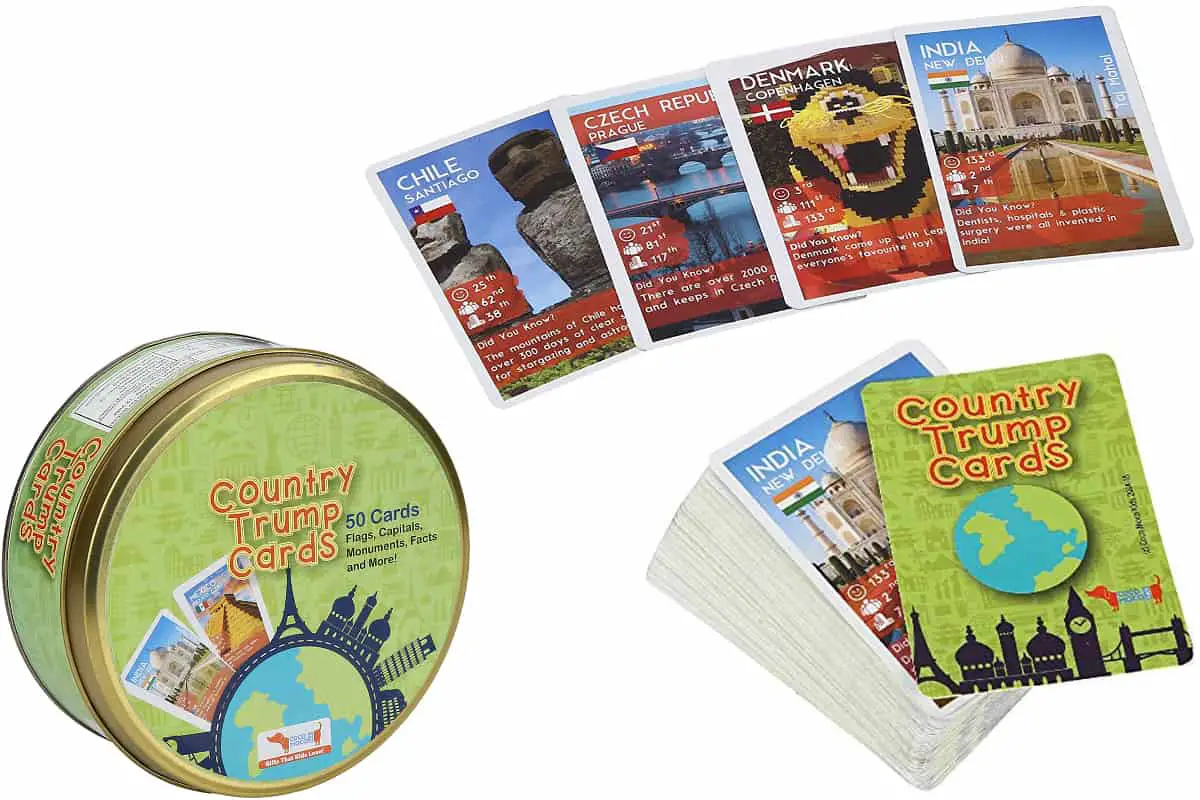
★★★☆☆
For Families | Age 5-12 | 2-5 Players
Country Trump Cards consists of 50 regular-sized cards packed in a tin box. The information on each card includes:
consists of 50 regular-sized cards packed in a tin box. The information on each card includes:
- Flag
- Country, Capital
- A Monument or other well-known spot
- A fun fact
- Rankings of Happiness, Population and Area of each Country: these are not very helpful from the educational point of view (why not also give the actual population?), which is why I give only three stars to the game
To play this game at home with 2-5 players,
- Shuffle the cards & distribute them among all players equally
- For each round, decide the characteristic each player will place a bet on. It could be a ranking, colors of the flag, the fun fact, or other information on the card
- Ask each player to show one card
- The player with a card that is on top of the attribute asked for wins that round
- Continue until all cards are played
- The player with the highest score wins the game
It can also be used in other ways:
- As QUIZ cards: kids and adults learn about fun facts and monuments on top of basic information about different countries.
- Comparing rankings of Happiness, Population, and Area between countries
The game can be played with 5 to 6-year-old children. Just change the rules and make it less competitive. They can memorize the flags and countries by looking at the pictures.
Compared to other card games, the landmarks or monuments are colorful real pictures, which aids children’s visual memory. They also give an opportunity to explain what the specific landmark or picture is about (children are curious and will ask you anyway, so be prepared!).
I recommend this game for children for 6 or 7-year-old children because it encourages them to read geography facts (they are short and fun).
GeoCards World (GeoToys)
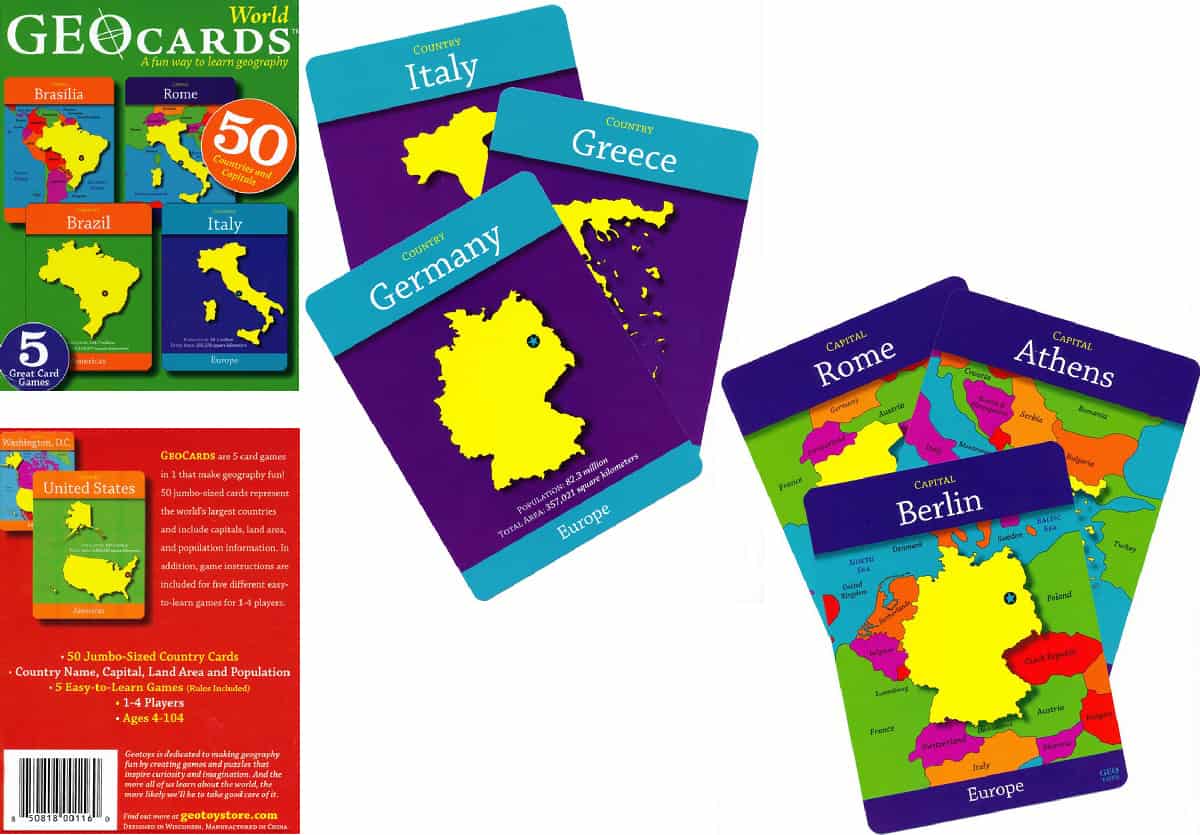
★★★☆☆
For Teachers and Families | Age: 4-up | 1-4 Players
GeoCards World comprises 50 jumbo-sized cards, each showing a state or a country on one side and capitals on the other, along with the country’s population, land size, and other facts about the country. There are five ways to play this game:
comprises 50 jumbo-sized cards, each showing a state or a country on one side and capitals on the other, along with the country’s population, land size, and other facts about the country. There are five ways to play this game:
- Name the Capital: A player shows the picture of the state or country while the other(s) guess it. It can also be played alone like a solitaire.
- Numbers War: players win by presenting a card with a population or land area larger than the opponent’s card.
- Players guess the continent in which a country is located.
- Guess the country (the most challenging): A player give clues about a country. The others must guess the country correctly based on the given hints.
Numbers War is a good start for preschoolers. It helps them to be familiar with Country names, capitals, and numbers. It is interesting that they start counting the number of digits, not the actual number itself.
However, this does not make them knowledgeable about the country because if the players ignore the information and pictures, they do not learn this information.
Primary school-age children (6-12 years old) might enjoy “Guess the country” because they can ask questions. It can be frustrating when they need to play this game a number of times to remember the facts on the card.
On the side, teachers who would like to introduce a lesson on capitals and continents can use GeoCards World as
- learning material in the classroom because the cards are big, colorful, and appealing
- Visual aid for ice-breakers, a warm-up activity, or a classroom reinforcement activity
All things considered, if your primary concern is increasing language skills through geography-related questions, I recommend GeoCards World for school-age children. However, other than memorizing capitals, continents, and 50 countries, this game does not offer much geography knowledge.
Countries of the World Card Games For Primary School-Age Children and Adults
In this section, I list four card games that are appropriate for school-age children and adults because they:
- can follow instructions
- have more patience in turn-taking
- are open to increasing the difficulty of the game
- can acquire and comprehend multiple pieces of information
The following games include card games that offer vast information about geography. The topics are not limited to facts about states, capitals, and trivia.
Geography encompasses different systems such as:
encompasses different systems such as:
- Physical (landforms, climate, rivers, etc.)
- Human (culture, migration, economics, and politics)
- Biological (habitat, species, dispersal, adaptation)
- Space (location, distance, area)
Here is a more detailed review of each game.
Country Quest (TNT Gaming Company)
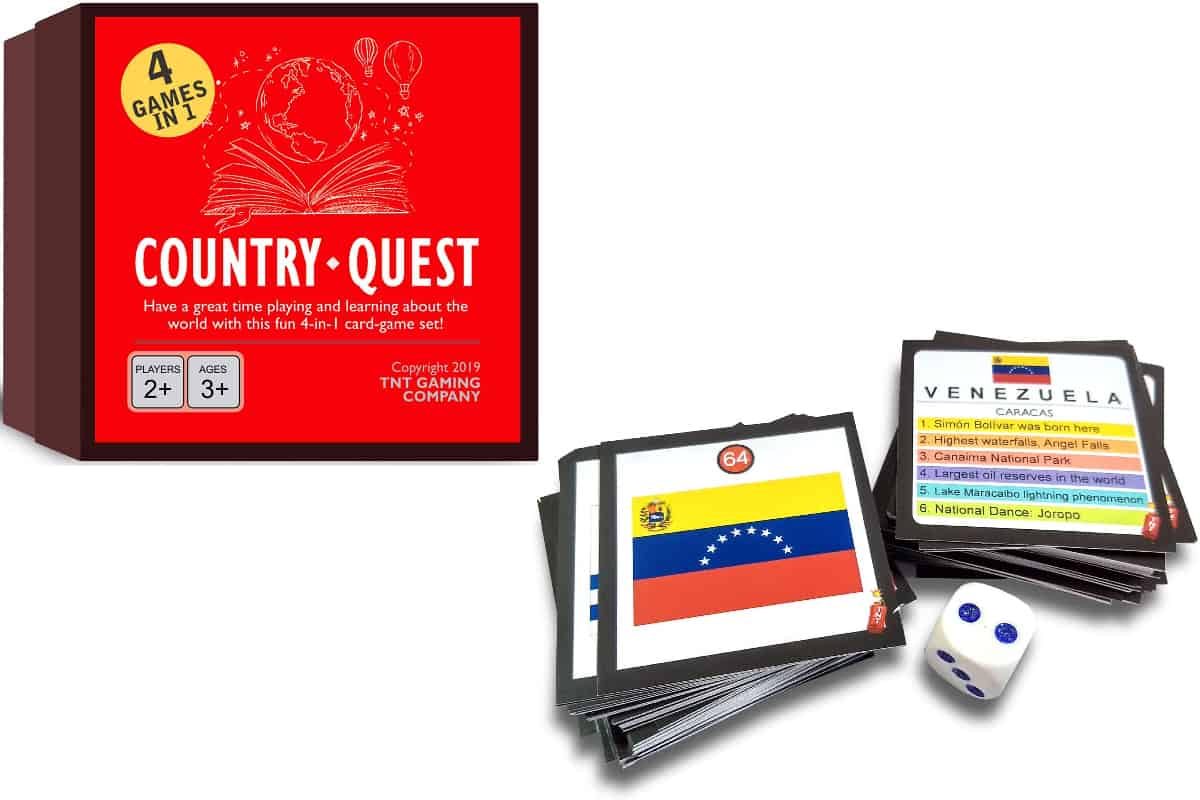
★★★★☆
For Families | Age: 6-up | 2-5 Players
Country Quest is an interactive game with the following material:
is an interactive game with the following material:
- 65 country cards that feature: country name, capital, flag, and six trivia facts
- 65 flag cards
- A World map, which helps learn the locations of the countries
- A sheet with for all countries: country name & capital
(and the flag card & country cards numbers to find them more easily) - A Dice
Its small packaging makes it portable.
Here are the four rules (each one should not take longer than 30 minutes to play):
The Conqueror
- Players take turns guessing the country of the flag card placed at the center.
- The player who first guesses the flag correctly keeps the card.
- The player with the most cards wins the game.
It’s a Match!
Players must match the flag and country cards they have, and set aside the successful pairs.
- Deal each player 5 Flag cards and 5 Country cards, and put the remaining flag and country cards at the center as a pile.
- Players take turns picking a card from the pile until all cards are paired.
- The first player with no cards left wins.
Where Am I?
- Place the country cards on the center.
- The first player picks a country card from the pile.
- The second player throws a dice.
- The first player reads the fact corresponding to the number on the dice.
- The second player must guess the country correctly. If not, the next player rolls the dice and will be given a hint by the first player based on the dice’s number.
- If no one guesses the country correctly, the card is placed at the bottom of the pile.
- The player who answers correctly keeps the capital card.
- The player with maximum cards wins the game.
Country Cool
- Mix up flag and country cards and deal them among players equally.
- Each player must be able to match:
- Country and its flag
- Country and its bordering countries
- Countries within the same continent
- Players take turns in showing one card at a time.
- The next player tries to match the previous card based on the mentioned criteria and gets all the cards if successful.
- The player with the most cards wins.
The first two rules are suited to 6 to 10-year-olds, while the other two are best for 11 years olds and above.
When it comes to learning geography, Where Am I? provides the opportunity to learn interesting information about the country. Each card has 6 facts such as
- A famous person
- A unique feature
- Most visited landmark
- Natural resources
- Landforms
- Climate
- Current events or historical tidbits
The game’s cards are not sturdy. Despite that, I recommend Country Quest for 6-8 years olds. They will memorize flags and capitals fast. It can be enjoyed repeatedly but increasing their geography knowledge as they age.
Professor Noggin’s Countries of the World Card Game (Outset Media)
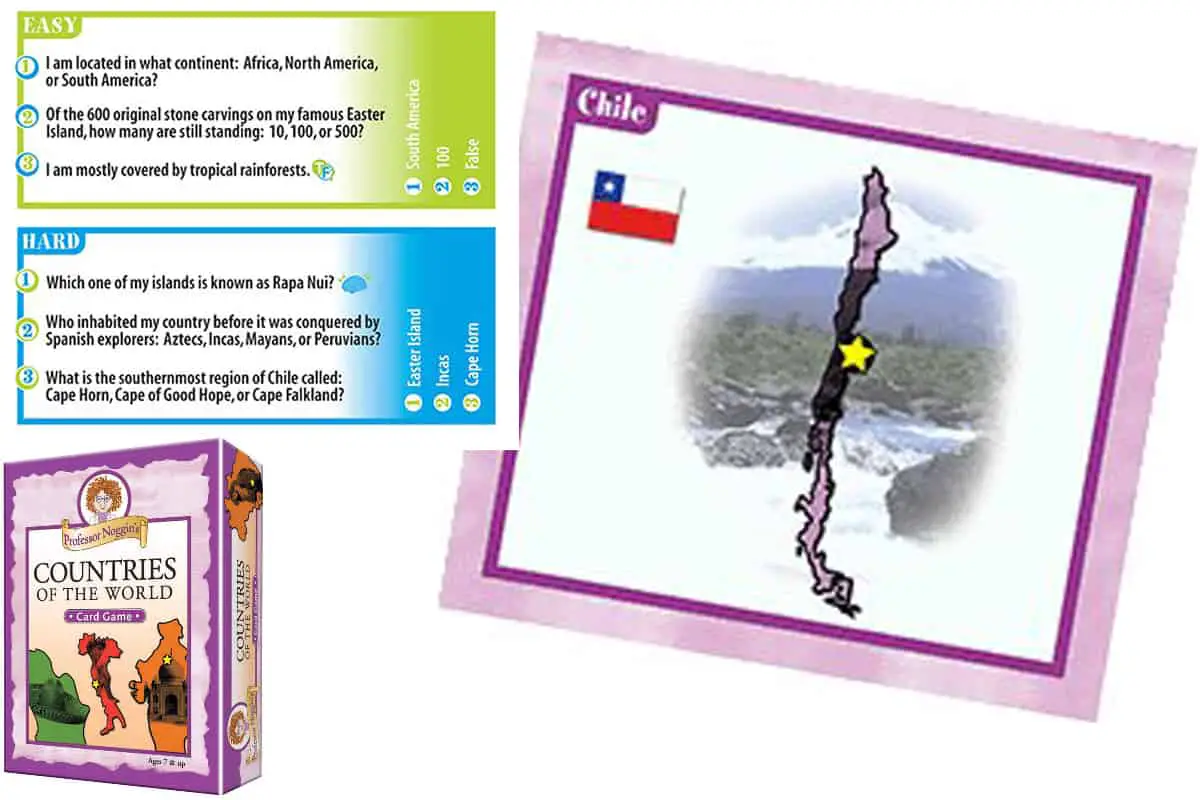
★★★★★
For Families | Age: 7-up | 2-8 Players
Professor Noggins is a quiz-type game. It includes a die, instructions, and 30 cards with:
is a quiz-type game. It includes a die, instructions, and 30 cards with:
- On one side: a picture and map outline of the country
- On the other side: 6 questions (3 easy and 3 hard ones) and their answers on the right. There are a total of 180 questions which combine trivia, true-or false and multiple choice questions.
Examples of Easy questions:
- I am located in what continent: Africa, North America or South America?
- Of the 600 Original stone carvings on my famous Easter island, how many are still standing? 10, 100 or 500?
- I am mostly covered by tropical rainforests? (True or False)
Examples of Hard questions:
- Which one of my islands is known as Rapa Nui?
- Who inhabited my country before it was conquered by Spanish explorers: Aztecs. Incas, Mayans or Peruvians?
- What is the southernmost region of Chile called: Cape Horn, Cape of Good Hope or Cape Falkland?
In this game, players memorize the country by looking at the picture. They learn a lot about geography because questions include:
- Continent
- Location
- History
- Culture
- Landforms
- Statistics
To play the game, players place the pile of cards at the center of the table, and take turns rolling the three-numbered dice:
- The number on the dice determines the number of questions the players must answer
- The card goes to the player who first provides the answer (if correct). If the answer is incorrect, the card is returned to the bottom of the pile.
- The player with the most cards at the end of the game is the winner!
If a player gets the Noggin’s Choice card, they do not need to answer the questions and can get a card from any other player to advance in the game.
To win this game you need to remember the correct answers. This is OK at home but less so at school where stronger players will always win. But you can change the rule to make it cooperative and therefore suitable for schools (which is what most teachers will do anyway).
6 or 7 years old children may find the game difficult as they are still early readers. To play with young and older players (adults for example), older players can answer the Hard questions while younger ones answer the Easy questions. This enables to keep the competitive nature of the game while playing with children and adults at the same time.
Although the card topics are limited to 30 countries, there is variety in the information so that both children and adults can learn.
The World Game (The World Game)
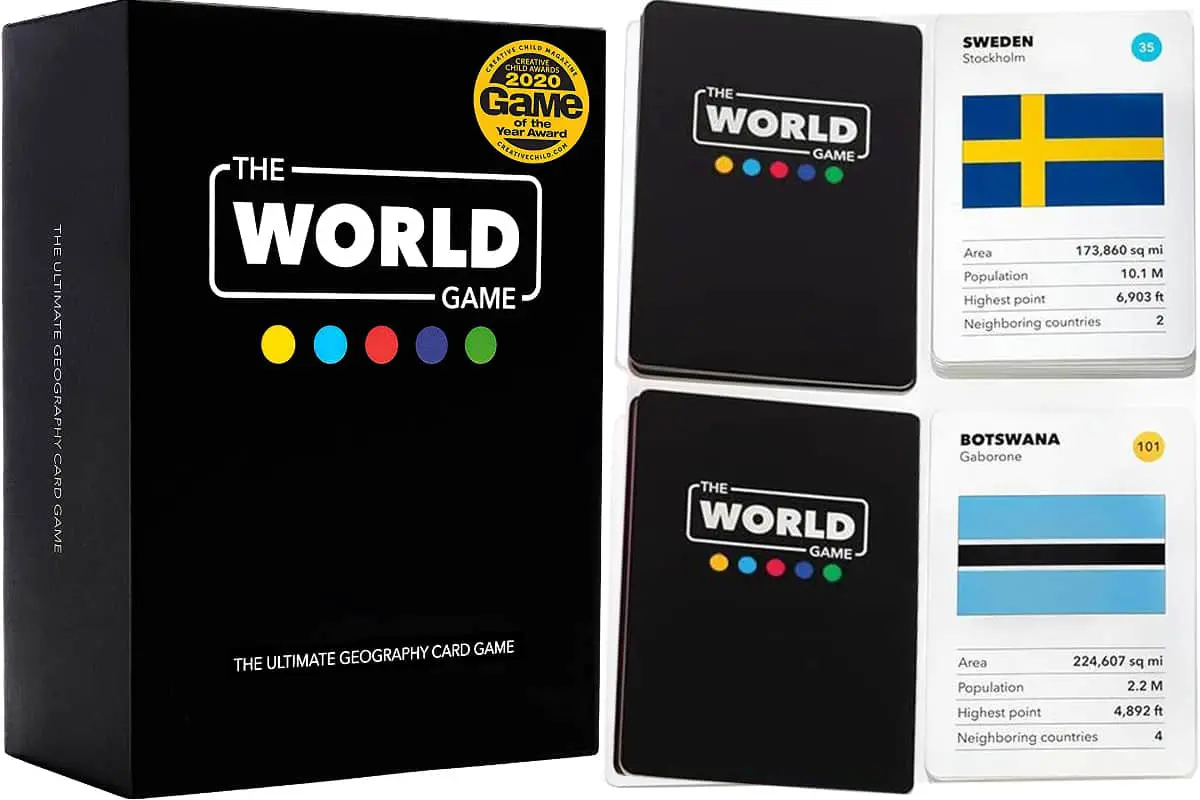
★★★★☆
For Teachers and Families | Age: 7-15 | 2-5 Players
The World Game is a second runner-up in this list for game variation and design quality. The cards are neat, colorful, sturdy, and easy to hold.
is a second runner-up in this list for game variation and design quality. The cards are neat, colorful, sturdy, and easy to hold.
It consists of all 194 countries and a foldable world map.
It can be used as a flashcard to quiz yourself about each country’s trivia, or you can enjoy it with a bunch of friends or loved ones while on a road trip like a trump card.
Give each player a set of 20-30 cards. For each turn, one must find the strongest fact about the country on hand. The player who holds the figure or attribute according to the category of debate wins.
Players can compete using rankings in 4 challenges such as:
- Flag
- Capital
- Continent
- Location
Rankings include :
- Area
- Population
- Highest point
- Neighboring countries
In short, this card game is suitable for memorizing capitals, countries, and locations on the map. Once you learn all these, that’s it! Its educational content is limited to quick facts and figures.
Despite that, this card game can be enjoyed in the classroom in several ways.
- Divide the class into groups of five members. Ask them to spend time matching the flags and country to the location on the map.
- Take the game up a notch by asking players to identify the country on the map, describe the flag or name the capital city using the location on the map. This activity is best played in the classroom as the main activity for geography lessons in countries for at least 30 minutes.
- Teachers can also tune the difficulty of the game by increasing the number of characteristics per round. You can start using it as a flashcard for basic information like the country’s name. Then, you can challenge the students to recite the coolest fact or statistics about the country.
Note that the foldable map is quite small for group games.
At home, parents can give 5 to 10 cards to each player to shorten the play. Asking the players to play the game faster also makes it more exciting.
I recommend The World Game for 9 to 12-year-olds because:
- It covers almost all countries
- You can change the difficulty and speed of the game according to the skill level of the players
Top Trumps Countries of the World (Top Trumps)
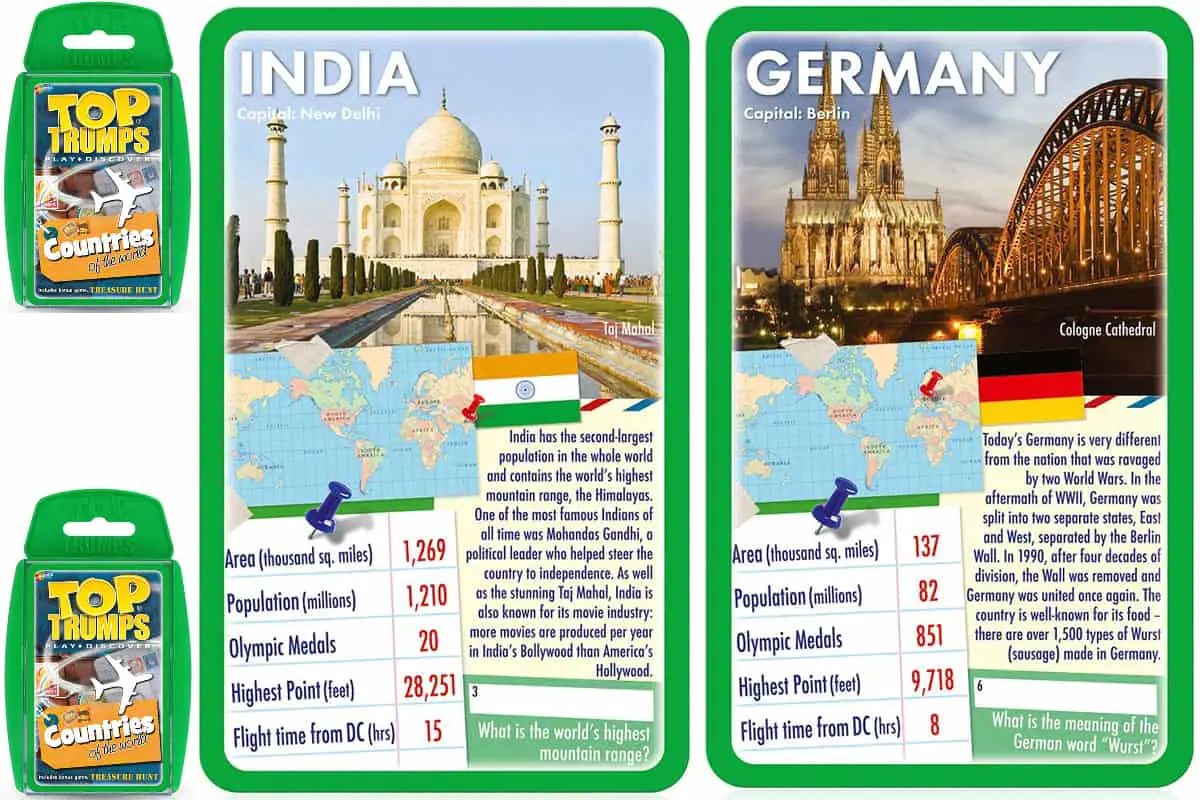
★★★★★
For Families | Age 7-15 | 2 to 6 players
Top Trumps consists of a deck of glossy cards with 30 countries.
consists of a deck of glossy cards with 30 countries.
The game mechanism is that the player to the left of the dealer chooses a characteristic on their card that they think is the strongest. The players make a duel with this characteristic, and the one with the highest characteristic wins. This game mechanic is popular and fast-paced, making it a favorite when you have to kill some time.
Characteristics include:
- The highest point, in feet
- Population
- Land area
- Number of Olympic medals
- Flight time from Washington DC
The cards also feature the country’s capital, a small text presenting the country and a riddle (the answer is on the rule sheet), and a picture representing a country’s remarkable area with its name.
7 to 9-year-old children will find this game exciting and benefit most from gaining quick familiarization with countries’ names and other facts. The pictures are very good too which is a plus.
I do not recommend for Pre-teens (10 to 12-years-olds), as the game will be too easy with only 30 countries.
OK, this is with Dinosaurs, but the same rule applies for countries 🙂
Edudingo.com is a participant in the Amazon Services LLC Associates Program, an affiliate advertising program designed to provide a means for sites to earn advertising fees by advertising and linking to Amazon.com. We also participate in other affiliate programs which compensate us for referring traffic.

